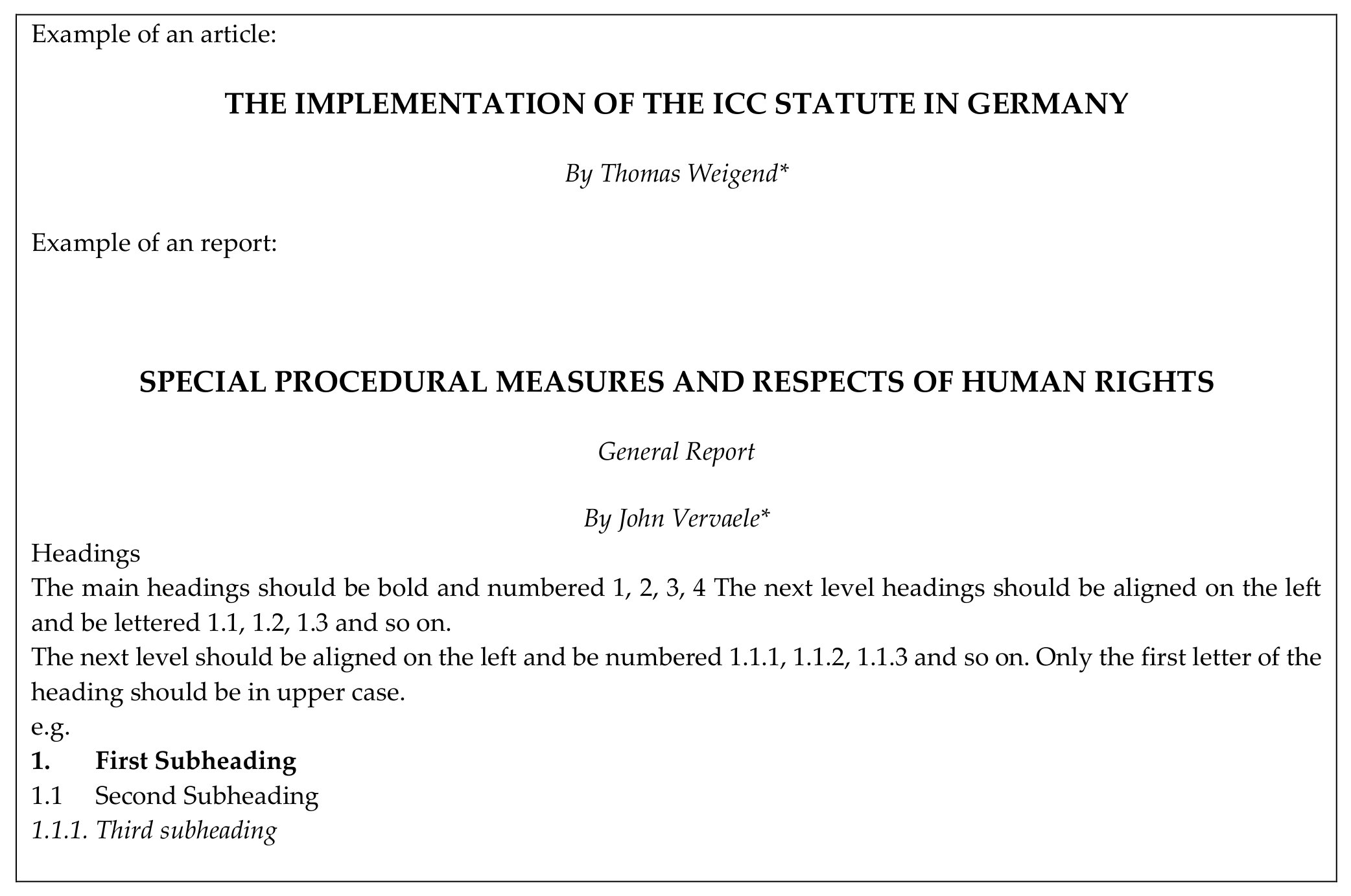RIDP STYLESHEET | AUTHOR GUIDELINES
All contributions may be sent to ridp@penal.org.
1. Referencing
Contributions made to the RIDP use the Oxford University Standard for Citation of Legal Authorities (OSCOLA) and
reference in accordance with those standards. OSCOLA is a ‘footnote style’ –all citations appear in footnotes. It does
not use endnotes or in-text citations. A detailed referencing guide can be find on the OSCOLA website
(www.law.ox.ac.uk/oscola). This website also contains support materials for Endnote and other bibliographic software
and a link to Cardiff University’s online tutorial for OSCOLA.
2. Layout of the manuscript
2.1 Format for submission
2.1.1 Font, Size and Margins
Articles should be submitted in ‘Palatino Linotype’, font size 9.5, single spaced. The main heading/title of the
contribution should be in font 11, sub-headings should be in font size 10, while footnotes in font size 8. All margins
between paragraphs as well as after the headings are single spaced. The entire manuscript of the journal issue may not
exceed 350 pages. Accordingly, the Editor can impose limitations on the length of the authors’ contribution.
2.1.2 Format
The author should submit the article in Word version in the required format. The attached dot.format providing a
technical template with fixed headings enables the author to easily submit his or her paper in the correct format. The
editor can then easily merge all articles into one manuscript.
The page numbering should be inserted as follows: even numbers appear on verso pages on the bottom left corner,
while odd numbers appear on recto pages on the bottom right corner.
2.1.3 Necessary elements
Articles submitted to the RIDP should have an abstract (100-200 words, Italic), an introduction (300-700 words), a body
and a conclusion (300-700 words).
For the resolutions and reports, no necessary divisions are required.
Title
The title of each part should be centred, in CAPITALS and bold, with the author in Italic preceded by ‘by’ underneath
the title. The author should include an asterisk behind his name and include a small professional description (20-30
words). If it is a report or a resolution, a subheading should be added between the title and the author to clarify the
content (e.g. report, resolution).


Headings and Subheadings
We ask of authors to use a consistent system of headings as outlined below:

2.2 Language
Authors are strongly advised to check the spelling and grammar (e.g. via the Word in-built Spell Checker or by
submitting it to a proofreader) and clarity of their articles before submitting.
2.3 Italics and Emphasis
Italics should be used for the following:
- Cases E.g. Lubanga Case, Pinochet Decision.
- Titles of published books e.g. The Trial Proceedings of the International Criminal Court
- Titles of periodicals e.g. Panopticon
- Phrases, names or words in foreign languages e.g. Code pénal
- Latin phrases e.g. nullum crimen sine lege
- the author wishes to emphasize a certain word or phrase. A footnote should further explain that the quoted passage
- is emphasized by adding (emphasis added). Bold text should not be used (save for headings).
2.4 Abbreviations
- General Rule: Abbreviations should be followed by a full stop e.g. Doc., Cf.
- Exception to the general rule: Acronyms do not have full stops, e.g. EEC, ECHR, ILC, ICC, UN, US/USA, UK.
- Abbreviations for expressions, institutions or common doctrine may be used but should be introduced when first
- appearing, e.g. International Criminal Tribunal for the Former Yugoslavia (ICTY).
2.5 Quotations
- General Rule: For quotations, single inverted commas should be used throughout the document. The closing full stop should be inside the closing quotation mark, if the quotation forms a complete sentence. If not, it should be outside it. Passages of more than three lines should be set off from the rest of the text (block quotations), presented in a separate paragraph and indented without quotation marks (Single Indent)
- Double inverted commas are reserved for quotations within quotations.
- Begin with an ellipsis (...) to indicate an omission of words in a quotation, with a space on either side. There is no need for square brackets. Example:
... there is no precise formula that will determine the extent of detail called for when a director declares his interest or the nature of his interest. ... His declaration must make his colleagues ‘fully informed of the real stat of things’ ...


